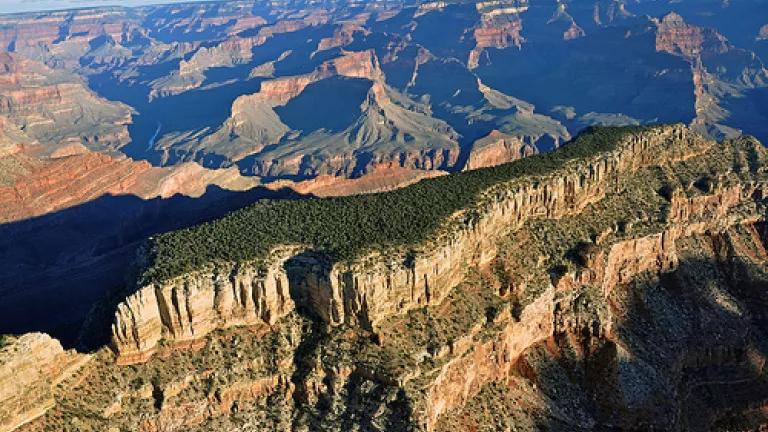
The Grand Canyon. Protection of this icon is directly due to the Antiquities Act (photo: NPS)
Since 1906, sixteen U.S. presidents have used the landmark Antiquities Act to permanently protect such beloved national treasures as the Grand Canyon, the Statue of Liberty, and the Olympic National Park.
Now a member of Congress wants to upend that proud history by gutting the law that grants presidents the authority to protect iconic areas -- federal lands that are already owned by the public..
The House is considering H.R. 1459 by Rep. Rob Bishop (R-Utah), deceptively named the "Ensuring Public Involvement in the Creation of National Monuments Act.”
Don't be fooled. The bill isn’t about ensuring public involvement; it’s about ensuring that no new lands get protection. Under the Bishop bill, it would be very difficult for any president ever again to protect federal land by declaring it a national monument.
Rep. Bishop claims he’s ensuring public involvement by making monument designations subject to the National Environmental Policy Act (NEPA), the landmark law that requires environmental reviews of federal actions. Bishop makes it sound like there are no NEPA reviews related to monuments now. But that’s simply not true. The plans on how to manage monuments – that is, the actual rules that govern land use – are already subject to NEPA. What isn’t subject to NEPA is the initial decision to protect land; that’s not a decision that can create environmental harm.
NEPA was not designed as a tool for deciding whether to safeguard a place from destruction or preserve lands in perpetuity. In truth, Bishop’s attempt to change how NEPA is implemented is simply a Trojan Horse, by affording opponents of national monuments a new means to forestall timely action even when there is a need to act.
Congress passed the Antiquities Act of 1906 to specifically provide a means for the President “to declare by public proclamation historic landmarks, historic and prehistoric structures, and other objects of historic or scientific interest” for lands owned by the federal government. This authority, granted by Congress, allows a President to establish national monuments as a means to secure these protections. But H.R. 1459 would practically halt the President from using the Antiquities Act to protect deserving lands in a meaningful way. Opponents of land preservation like Rep. Bishop like to claim that the Antiquities Act is a “land grab.” But that’s a baseless charge. Proclamations associated with the Antiquities Act can afford additional protections to public lands only for places that are already held in trust by the federal government. After these lands become national monuments they are managed by the exact same federal agencies that were managing them before.
In the last decade, Presidents Bush and Obama have used the Antiquities Act to establish protections for key wildlife areas in the West such as New Mexico’s Rio Grande del Norte; protect the home and workplace of César Chávez, the famous civil rights leader; and create vast ocean preserves including the PapahÄnaumokuÄkea Marine National Monument, part of the Hawaiian Islands.
One only has to look at the last few years of Congress to see why the Antiquities Act continues to be so important: Congress has passed only one wilderness bill since 2009 even though a suite of bipartisan lands bills have been introduced. Given the hostility that Republican leadership has for conservation bills, particularly in the House, the Antiquities Act has becomes an even more critical tool for advancing this nation’s conservation heritage.
Given that dismal track record, it is no surprise that Rep. Bishop – who holds a key leadership position in the House Natural Resources Committee, the committee which has jurisdiction over federal lands – seems dedicated to undermine any law that could protect federal lands. Bishop’s scorn for the Antiquities Act is well established, and is colored by the Clinton administration’s creation of Utah’s Grand Staircase-Escalante National Monument in 1996. The Grand Staircase-Escalante in southern Utah represents some of the most awe-inspiring 1.8 million acres found anywhere But the lack of significant federal protections before 1996 left this stunning land imperiled by a range of threats.
President Clinton’s use of the Antiquities Act to protect this region was unpopular with Utah’s political leadership, but it has proven to be an inspired and popular one. And in one particular way, the creation of the Grand Staircase-Escalante National Monument has spurred tremendous economic growth in the region. A 2011 study from the nonpartisan research group, Headwaters Economics, established that in the decade after the creation of the Escalante Monument, job growth grew by 8%, and personal income increased by 40%. This trend was not unique to southern Utah, though, for the same study established that 17 communities with national monuments created in the last two decades resulted in positive economic growth for adjoining rural communities. A report issued this week from the University of Utah also confirmed this economic trend, demonstrating that tourism represents Utah’s second largest industry , generating $7.4 billion in revenues in 2012 – much of it generated by activities that rely on the stewardship and protection of federal lands in the state.

